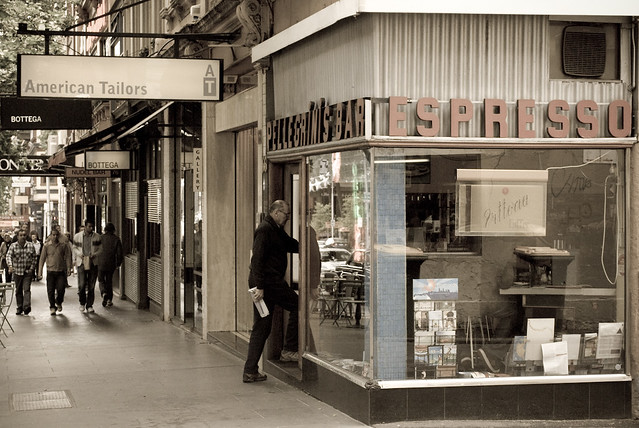Unlock the Magic in Your Story Now
Get the Free 20 questions to Ask Before Launching Your Idea workbook when you sign up for occasional updates.
Get the Free 20 questions to Ask Before Launching Your Idea workbook when you sign up for occasional updates.
Faith Vs. Proof
filed in Marketing, Strategy, Success
 In a digital world, where customers have infinite choices, and loyalty is precarious, it’s easy to believe the more information we give people, the better.
In a digital world, where customers have infinite choices, and loyalty is precarious, it’s easy to believe the more information we give people, the better.
It turns out that the opposite is true. We’re more likely to retain customers, get repeat sales and be recommended by simplifying the decision process.
What people want is the quickest way to discern if they can trust us and our offering.
Our customers don’t always want more proof—often what they need from us is more faith—not just in us, but in themselves.
Image by Sam Wheeler
Share this article
The One And Only
filed in Success
 You will not outthink your competition. Neither will I. None of us will.
You will not outthink your competition. Neither will I. None of us will.
We will never outwith, outsmart or even outrun them.
We will not outmanoeuvre, outguess or outdo them either.
The truth is competing is a zero-sum game. We succeed when we make peace with the fact that we don’t need to compete when we know who we are.
Every smart, brave, generous member of the Right Company is building the business only they can build.
This is the last time we’ll be inviting membership applications to the Right Company for 2019. If you want to succeed on your own terms, it might be for you.
Image by Boudewijn Huysmans
Share this article
Better Marketers Show And Tell
filed in Marketing, Story Skills, Strategy
 Every day, we sell ourselves in adjectives that sell us short.
Every day, we sell ourselves in adjectives that sell us short.
Leader, expert, communicator, specialist, efficient, experienced, better, faster, cheaper.
We’ve forsaken the effort of showing, for the convenience of telling.
There is a better way.
Don’t just tell us about the features and benefits of your product.
Show us how that product changed the lives of the people who used it.
Don’t just tell us about the services you offer.
Show us how you helped your client achieve the outcome they dreamed of.
Don’t just tell us about your skills and expertise.
Show us the impact those skills had on someone or something.
Your work matters. Show us why.
Image by Susan Jane Golding
Share this article
Do’s AND Don’t Do’s
 Clare’s accountancy clients tell her she’s like a breath of fresh air.
Clare’s accountancy clients tell her she’s like a breath of fresh air.
When she started her company, she took time to onboard her clients— walking them through how she could help them, taking a pile of paperwork and other mental clutter with her as she left. Nothing was too much trouble. Clients valued her approach, and her business thrived.
But as Clare’s business grew, her posture started to shift. She was too busy to serve people in the way that had originally differentiated her company. Small mistakes were made, and apologies overlooked. She stopped picking up the phone. As her business scaled, Clare continued to do her job, but she’d forgotten to show she cared. And that made all the difference.
The day came when her very first client decided they should part ways. Clare understood immediately that she’d lost this client because of the one small thing she could have done, but didn’t do.
It’s worth remembering that it isn’t only what we do that people notice— sometimes it’s what we don’t do that determines our results.
Image by Cowomen.
Share this article
Purposeful Connection
 Our new neighbour Bob is renovating the old terrace house next door. Well, when I say renovating, what I mean is rebuilding the entire house from the top down. The roof is off, and there’s not much left but a shell of the existing property.
Our new neighbour Bob is renovating the old terrace house next door. Well, when I say renovating, what I mean is rebuilding the entire house from the top down. The roof is off, and there’s not much left but a shell of the existing property.
It’s not the first time Bob has taken on a project like this, and it shows—not just in how he organises the team of builders, but in how he communicates with the people who will be affected by the work. Namely us.
Before work began, Bob’s first move was to invite us onsite to walk us through his plans. His second was to show us the common wall that needs to be rebuilt and to explain how he will fix it for our mutual benefit. The third was to give us his phone number, with instructions to call if we’re concerned about anything.
Bob has taken the time to empathise with us, his new neighbours. He’s anticipated our fears and our questions. He’s made us feel like we’re in good hands. And even though we barely know him, we trust him.
It turns out that we don’t have to build connection and trust on the fly.
We can do it on purpose.
Image by David Siglin
Share this article
Being Heard Is Overrated

It’s easier to be heard when we shout. But being heard needn’t be our ultimate goal.
What if we aspired to be listened to instead?
To be embraced rather than just noticed.
To be valued rather than used.
To be sought out and remembered.
To be recommended and treasured.
To be loved.
Image by Felix Koutchinski
Share this article
Your Brand Is What You Consistently Do
filed in Marketing, Storytelling, Strategy

‘There’s nothing remarkable about what we do here,’ my hairstylist Leanne says, as I take a sip of the iced water, flavoured with fresh lime, placed next to a pile of new magazines and the coffee menu, by the receptionist who shows me to my seat.
‘It’s just what we do.’
And that’s the point. It’s what they consistently do—every time, without fail, that differentiates this business from the twenty others in the same suburb, where I could get my hair cut faster and cheaper.
The kind of people they consistently employ.
The type of products they consistently use.
The service they consistently deliver.
The promises they consistently make and keep.
Choices greater than the sum of their parts, that combined create a brand clients are loyal to, and a story they want to tell.
Image by Guilherme Petri
Share this article
Earning A Competitive Advantage
filed in Marketing, Story Skills

The German restaurant in our neighbourhood closed its doors after a year in operation. The chef’s reputation and inventive menu were not enough to draw sufficient numbers of customers to make it viable.
We knew it was only a matter of time before another owner took over the lease. And sure enough, last weekend we saw a new coffee machine installed and the tables and chairs being delivered.
There are six cafes selling great coffee and a decent brunch within a hundred metres of this one. So, what does the owner believe her competitive advantage will be?
Few new businesses have an unassailable advantage—one that makes them the only choice for a prospective customer. Most don’t make measurably superior products or own proprietary software. They haven’t patented a secret formula, and they don’t necessarily have more resources or talent than the next company.
Successful companies don’t expect to start out ahead of the game on day one. They plan to earn an advantage over time, by knowing who they want to serve, and how—then building on their strengths to tell the story that matches their ideal customer’s worldview.
And when they do, they give their customers a story to tell, compounding their advantage as they go.
Image by Valberg Larusson
Share this article
The Unfair Exchange

‘That will be eight dollars,’ the woman, who is carefully weighing and wrapping two serves of freshly made fettuccine for us to take home, says.
As my husband is about to hand her the cash, she takes another handful of the pasta from behind the glass and adds it to our package.
She doesn’t announce that she’s giving us twenty per cent extra for free.
She doesn’t even invite us to notice the gesture at all.
It’s enough for her that she knows she has added value.
We think of value as a hard metric—the anticipated fair exchange of this for that.
But value can be a surprising, generous, unfair exchange.
Something that is given because we can, not because we must.
Image by Maria Molinero
Share this article
Better Customers

A young friend of mine who moved to a new city was having trouble making friends.
She lamented about not meeting the right people.
‘How can I make good friends?’ she wondered.
Her question reminded me of something my grandmother used to say.
‘You get good friends by being a good friend.’
What would happen if we applied this advice to business?
What if we doubled down on delivering good service as a strategy to get good customers?
There are two questions we’d need to ask at the outset.
1. What’s our definition of a good customer?
2. What are our customers’ ideals about the companies they want to support?
When we know who we’re building for and what they care about, we get better.
The Story Strategy Course shows you where to begin.
Image by Jenny Marvin